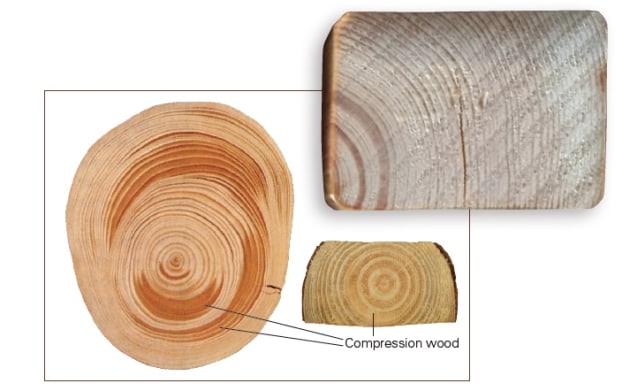Reaction wood
Above: Curved trunks are an indicator of reaction wood.
Trees grow upward towards light. If a tree is subjected to natural forces, such as prevailing winds, loading from snow, ice, rocks or soil, or if it grows on a slope, it will still grow in such as a way as to bring its stem back to a vertical position. Reaction wood is the term used to describe the abnormal woody tissue which can develop in response.
Reaction wood develops in different parts of the tree in softwoods and hardwoods. It differs physically, microscopically and chemically, but also exhibits similar properties which affect the processing of wood and products in service.
In softwoods, reaction wood is called compression wood (CW) and is laid down on the underside (compression side) of the bend. In hardwoods, reaction wood is formed on the upper side of the leaning, bent stem or branch and is called tension wood (TW), so-called for its assumed state.

Eccentric and darker zones in the larger cross-cut section show compression wood. Markings on the smaller cross-section are not as apparent – wetting such surfaces can reveal them more distinctly.
Signs of compression wood
Crookedness or sweep in a log and distorted boards are signs of reaction wood. Examination of the end of a bent stem usually shows eccentricity around the pith in which the wider part of the stem contains the reaction wood, often with wider or darker coloured portions of growth rings.
Severe compression and tension woods show zones of increased density and hardness, usually appearing darker. However, tension wood is often difficult to detect and sometimes appears silvery and other times dull and lifeless. On log-ends, billets and endgrain, severe reaction zones can be seen with the naked eye but as the severity diminishes, they can be difficult to detect macroscopically.

Showing collapse in severe tension wood as well as cracks from high drying stresses across and along the grain. The resulting collapse doees not respond to reconditioning as would normal wood.
Effects on end-use and processing
Properties of most concern from both CW and TW include abnormally high longitudinal shrinkage (along the length of a board) which can be up to 20 times higher than in normal wood from green to oven dry. Considering TW, transverse shrinkage (across the grain) is higher than normal wood and the tissue is prone to irrecoverable collapse because of reduced lignin content.
On the other hand shrinkage across the grain from CW zones tends to be lower than that from the normal wood because of the higher lignin content within the cell wall; the fibres are up to 30% shorter in length and have significantly less steep microfibril orientation which results in lower stiffness in spite of increased density.
In dry and drying wood
Distortions of components with reaction wood can arise during drying but can continue in dry components. Changes tend to occur from the slow release of built-in stresses. Presence of CW causes distortion and splits in veneer and plywood, as well as warp in framing timber and other components.
When machining
Reaction wood can pinch against a sawblade or splay widely apart when cutting. When carving, compression wood may reveal itself as abnormally hard or brittle. When stained it may not take uniform colour and be more prone to splitting when nailed into.
Both TW and CW have lower compression and impact strength relative to their density compared with normal wood.
Reaction wood fibres of TW contain a less than expected amount of lignin and more cellulose. Apart from wood distortions, TW is commonly stronger than normal wood but machines poorly, as fibres do not sever cleanly leaving a fuzzy or woolly surface.
Aside from difficulties in sawing TW, seemingly successful efforts to smooth the wood are inclined to leave microscopic woolliness on a surface which tends to absorb stain or finishes irregularly leaving the surface blotchy.
As the amount of reaction wood reduces it becomes increasingly more difficult to detect however it can still lead to problems. The pine internal door stile whose endgrain is shown above buckled after six months, so much so it was difficult for the door to latch. Examination of the stile’s endgrain showed that a band of CW was responsible.
When selecting wood it pays to look out for signs of reaction wood as machining and shrinkage problems can occur.
Dr Jugo Ilic worked as a wood scientist at CSIRO for 36 years. As part of his research activities he authored the CSIRO Atlas of Hardwoods and curated the Australian Wood Collection. He has written several articles for Australian Wood Review.



